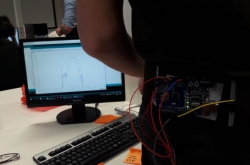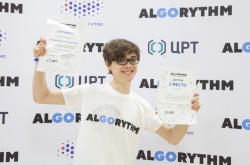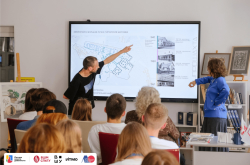More than 20 students from different countries came for the international Experimental Interaction Design course, where they had the opportunity to design digital environments that would provide for a new level of digital literacy and help humanity solve another problem - this time, from the field of healthcare.
During the first week, the students worked in teams to analyze the problems that have to do with modern lifestyle so as to choose relevant topics for their projects. The next stage was brainstorming for best solutions, and by the end of the first week the school’s participants already demonstrated their first prototypes. After testing them, the students were given one week to assemble their inventions. Each project had three supervisors.
The projects developed by Master’s students from ITMO University had to do with the sedentary lifestyle. The invention that Anna Ksenofontova worked on was for controlling the position of a person's back while he or she is sitting before a computer so as to avoid the development of problems related to bad posture. As a result, the team created a vest with a 3D sensor that could be used to track the back's position. The vest also featured motors that vibrated if one's position caused discomfort to his or her spine, and ceased only when the back's position returned to normal.
 Anna Ksenofontova and Anna Filippova
Anna Ksenofontova and Anna Filippova
They also developed a prototype of an application that can be used to adjust the vest in accordance to one's constitution and physiological properties, as well as to find the proper comfortable position to sit in.
All in all, four students from different countries worked on the vest; thus, for two weeks Anna worked together with students from Brazil, Estonia and South Korea.
"We spent the second week in the laboratory, where we turned our ideas into real devices. This stage of the summer school was new to us, and I have to say it was most interesting. During the whole course of the summer school, the university's professors gave lectures and oversaw our projects. As a result, in just two weeks we developed ready-for-use products. My team, for instance, presented a working prototype of a vest that reacts to a bad posture," shares Anna Ksenofontova.
 Anna's team with the prototype blueprint
Anna's team with the prototype blueprint
The other project, the one that Anna Filippova participated in, had to do with the problem of sedentary lifestyle in general. According to her, people spend lots of their time sitting - not just before a computer, but in many other places (for instance, many spend about 1,5 hours every day sitting in transport to just sit again after they get to work). The developers propose a system of devices - a wristband and a chip. One puts the chip into his the back pocket of his pants so as to track the time he spends sitting. The wristband is used for telling a person that he or she needs to stand up and have a walk. All of the system's settings can be adjusted using an application, the prototype of which has also been developed at the Tallinn University of Technology. The user can specify the time he's planning to spend sitting, as well as time periods for different activities.
The team working on the project was comprised of Anna, a student from South Korea and several students from Estonia. All of them specialize on developing interfaces.
 Anna Fillippova with the wristband prototype
Anna Fillippova with the wristband prototype
"The course organizers aimed to introduce us to the full development cycle, so that we could see this process from different sides. We acted as analysts, programmers, designers. Also, it was especially interesting to go all the way from an idea to a working prototype in such a short time," shares Anna Filippova.
According to the students, all of the participants got the same sets of parts for assembling their devices. Yet, in the course of working on the projects they could ask the organizers for additional components. Each team also had to write the programs for their devices.
 Participants of the Experimental Interaction Design summer school
Participants of the Experimental Interaction Design summer school
"We are really thankful to ITMO University and the Department of Engineering and Computer Graphics for such a unique and incredible experience. This course was international, so we got the chance to communicate with people from other countries and see how they solve the same problems as us. Also, we got great experience in assembling devices with our own hands," says Anna Filippova.





